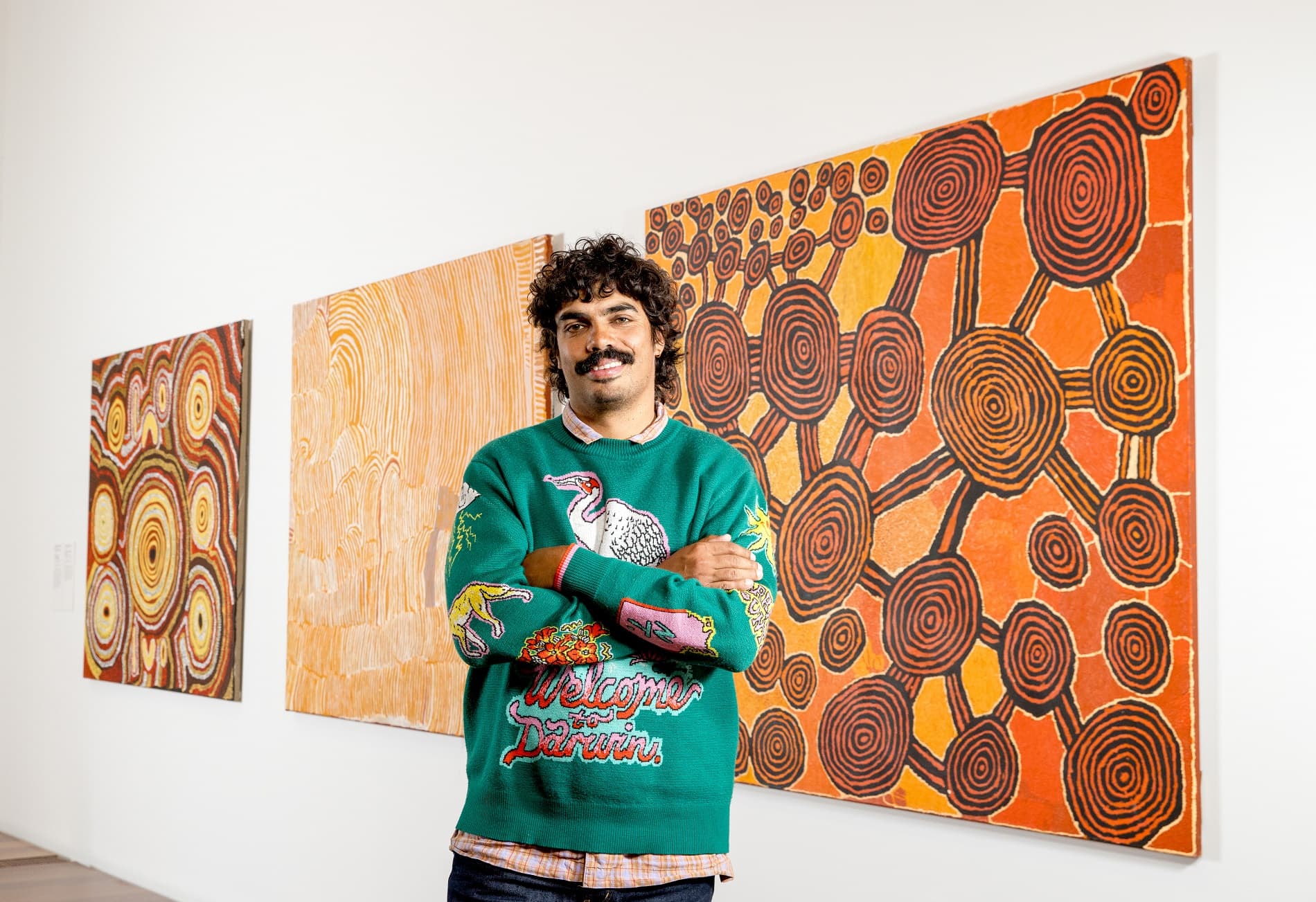Conceived and produced by the National Gallery of Victoria (NGV), Connecting the Dots: First Peoples Art from the NGV with Tony Armstrong is a four-episode podcast series that delves into the stories, works and artists in the NGV’s globally significant collection of Aboriginal and Torres Strait Islander art and design.
Inspired by the new ground floor galleries Wurrdha Marra, located at The Ian Potter Centre: NGV Australia from 12 October, the podcast series features interviews between Armstrong and trailblazing figures of First Peoples creativity who are challenging stereotypes and pushing contemporary discourse into new and surprising contexts. These include Destiny Deacon, Tony Albert, Keemon Williams and Amrita Hepi.
Through further conversations with NGV’s Director, Tony Ellwood AM, as well as Myles Russell-Cook and Sophie Gerhard, respectively Senior Curator and Curator of Australian and First Nations Art, the podcast will also contextualise the breadth and diversity of First Peoples art and design; how it has developed over 65,000 years; and the wealth disciplines used by contemporary practitioners working today.
Armstrong also speaks with Aunty Gail Smith, Wurundjeri Elder and Language Custodian from the Wurundjeri Council, who bestowed the new name Wurrdha Marra on NGVs ground floor Collection gallery, meaning ‘Many Mobs’ or ‘Many People’ in the Wurundjeri Woi Wurrung language and reflects the diversity of Australian First Nations Communities.
The podcast is hosted by multiple Logie Award-winning broadcaster and journalist, Tony Armstrong. A former Australian Rules footballer, in 2019, Tony broke new ground by becoming the first Indigenous person to provide live commentary for AFL on commercial radio. Armstrong has also presented sport for News Breakfast on both ABC TV and the ABC News channel since 2021, as well as other standalone documentary series.
Tony Ellwood AM, Director, NGV, said: ‘We are delighted to be working with Tony Armstrong to share First Nations stories with a wider audience through NGVs new Connecting the Dots podcast. We hope listeners will gain a deeper understanding of the incredible breadth of First Nations creativity in Australia, and visit The Ian Potter Centre: NGV Australia, the home of the world’s most significant collection of Australian First Nations art and design, to explore our incredible historic and contemporary Collection which is on display year-round.’
Tony Armstrong said: ‘I’m excited to be hosting NGVs new podcast, and I can’t wait for listeners to join me on a journey of discovering more about First Nations art, and to expand our understanding of what First Nations art really is.’
- EPISODE 1 – WURRDHA MARRA ‘MANY MOBS’ WITH WURUNDJERI AND NGV
In episode one of the podcast, Armstrong meets Aunty Gail Smith, Wurundjeri Elder and Language Custodian who shares the meaning behind the Wurrdha Marra name, meaning ‘Many Mobs’. Armstrong also speaks to Tony Ellwood AM, Director, NGV and Myles Russell-Cook, Senior Curator of Australian and First Nations Art, NGV about commissioning, collecting and presenting First Nations Art at NGV, and the role of galleries as custodians of material culture, and in storytelling for audiences. They also discuss how the exhibition, and NGVs Collection, celebrates the diversity of First Nations art and design through the work of First Peoples from around the Country. - EPISODE 2 – HUMOUR WITH DESTINY DEACON
Episode two interviews the internationally renowned contemporary artist Destiny Deacon, who is known for her nuanced, thoughtful and, at times, intensely funny snapshots of Australian life. Armstrong and Deacon discuss the artists incredible thirty-year practice, her coining of the term ‘blak’ and her work that has spanned photography, video, sculpture and installation. Together, Armstrong and Deacon discuss the use of humour as a way of making sense of tragedy. - EPISODE 3 – ILLUMINATING HISTORIES WITH TONY ALBERT AND KEEMON WILLIAMS
In episode three Armstrong talks to contemporary artists Tony Albert and Keemon Williams, whose works both look to reframe First Nations histories in different ways by appropriating found materials, language, and symbols of their culture. Williams is the youngest artist in the Wurrdha Marra exhibition, while Albert is a senior figure in the art world, known for using what he calls ‘Aboriginalia’ in his work. Both artists explore the intersection of queerness with Aboriginality, with a particular fondness for the aesthetics of camp. - EPISODE 4 – ABSENCE AND PRESENCE WITH AMRITA HEPI
In the final episode of the series, Armstrong interviews artist and choreographer Amrita Hepi, whose work challenges societal definitions of intelligence and the standards of Western knowledge systems, while inviting a reflection on language. Hepi joins Armstrong via Zoom from the Northern Hemisphere, for a conversation about ethics, intelligence, and ultimately, how the way we treat others says more about us than them.
ABOUT WURRDHA MARRA
From October, the ground floor of The Ian Potter Centre: NGV Australia, Fed Square will be home to Wurrdha Marra, a new dynamic and ever-changing exhibition space dedicated to displaying works from the NGV’s Collection of First Nations art and design. Wurrdha Marra means ‘Many Mobs’ in the Wurundjeri Woi Wurrung language and is the name newly bestowed upon this gallery space by the Wurundjeri Council.
Wurrdha Marra showcases emerging to senior practitioners from across time periods and from around the Country, including Tony Albert, Treahna Hamm, Kent Morris, Marlene Gilson, Rover Thomas, Christian Thompson, Gary Lee, Nicole Monks, Gali Yalkarriwuy, Dhambit Mununggurr, Nonggirrnga Marawili and more. Traversing the ground floor and foyer of The Ian Potter Centre: NGV Australia, Wurrdha Marra includes a number of new and never-before-shown works across a vast array of media. Wurrdha Marra celebrates the diversity of First Nations art and design through a series of visual dialogues and juxtapositions from many Aboriginal and Torres Strait Islander Communities around the Country.
